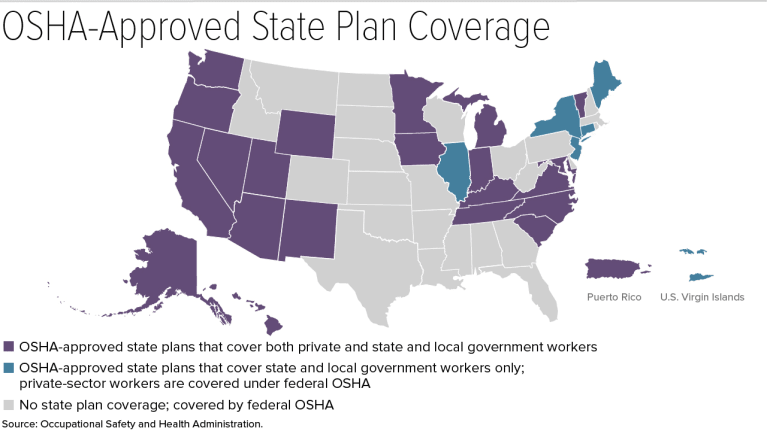This is the second in a series of articles about the Occupational Safety and Health Administration (OSHA). This article examines OSHA-approved state plans. Read the first part here.
Multistate employers may have to comply with more than one occupational safety and health (OSH) program, which means they must pay attention to nuances in regulations and administrative procedures.
State Plans
The federal OSH Act covers most private employers and their workers. However, OSHA allows states to develop their own workplace health and safety plans, as long as those plans are "at least as effective" as the federal program.
"When Congress passed the OSH Act in 1970, a compromise was reached to allow states to opt out of federal OSHA, subject to certain conditions," explained John Martin, an attorney with Ogletree Deakins in Washington, D.C. "Some states, such as California, already had state OSH agencies in 1970, and they did not want to lose them to the federal government."
Twenty-one states and Puerto Rico have OSHA-approved plans that cover private employers as well as state and local government employers. Five more states and the U.S. Virgin Islands have plans that cover only state and local government employers.
"It can be difficult for employers with multistate operations to get a handle on the nuances under each plan," according to Patrick Miller, an attorney with Sherman & Howard in Denver. Many state plans simply adopted the federal requirements, but even those plans may have different procedural hurdles, he said.
State plans have their own review and appeal systems. "The procedures are generally similar to OSHA's, but cases are heard by a state review board or equivalent authority," according to OSHA.

More Worker Protections
Some states have rules that are more stringent than the federal requirements, and some have standards that are not addressed by federal OSHA, said Bradford Hammock, an attorney with Jackson Lewis in Washington, D.C. He noted that California and Washington are examples of states with more expansive plans.
For example, the California Division of Occupational Safety and Health (Cal/OSHA) specifically addresses working in high temperatures outdoors. Covered employers must offer workers free, cool water and access to shade, among other requirements.
[SHRM members-only toolkit: Complying with California Safety Standards]
Federal OSHA doesn't have a specific standard that covers heat illness prevention. "Nonetheless, under the OSH Act, employers have a duty to protect workers from recognized serious hazards in the workplace, including heat-related hazards," according to the agency's website.
"Cal/OSHA's heat illness prevention program has been the envy of federal OSHA," Martin said. "Most of the heat illness prevention materials on OSHA's website borrow heavily from Cal/OSHA's program."
He said Cal/OSHA also recently enacted a standard to address incidents of workplace violence in health care, which is something federal OSHA has been wanting to do for years.
Miller noted that Cal/OSHA requires employers to have written injury and illness prevention programs, whereas federal OSHA does not. "That sets the bar pretty high," he said.
Some state plans specifically address predominant industries in the state, Hammock noted. For instance, Wyoming has a standard for the oil and gas industry. "But some regulations are near-universal," Martin said. For example, in general industry, virtually every state plan requires fall protection measures for working more than four feet off the ground, he said. "Record-keeping regulations all tend to look exactly like federal OSHA's requirements," he added.
Compliance Tips
Multistate employers should take a step back and figure out where work is being performed, Hammock said. It's possible that all the states in which an employer has operations fall under federal OSHA, or the business might have to comply with a mix of federal and state rules.
Hammock said employers should start with a base of federal OSHA compliance and then take a look at what additional standards apply. The federal OSHA website has a page for state plans, which is a good place to find information about compliance in each jurisdiction, he added.
"Stay on top of the state plan regulations," Martin said. "Assuming the state plan has the same regulations as federal OSHA may be a safe bet 80 percent of the time, but the differences can burn you."
Was this article useful? SHRM offers thousands of tools, templates and other exclusive member benefits, including compliance updates, sample policies, HR expert advice, education discounts, a growing online member community and much more. Join/Renew Now and let SHRM help you work smarter.


